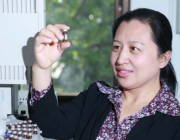摘要:
Ambient aerosol samples were collected at an urban site and an upwind rural site of Beijing during the CAREBEIJING-2008 (Campaigns of Air quality REsearch in BEIJING and surrounding region) summer field campaign. Contributions of primary particles and secondary organic aerosols (SOA) were estimated by chemical mass balance (CMB) modeling and tracer-yield method. The apportioned primary and secondary sources explain 73.8% +/- 9.7% and 79.6% +/- 10.1% of the measured OC at the urban and rural sites, respectively. Secondary organic carbon (SOC) contributes to 32.5 +/- 15.9% of the organic carbon (OC) at the urban site, with 17.4 7.6% from toluene, 9.7 +/- 5.4% from isoprene, 5.1 +/- 2.0% from alpha-pinene, and 2.3 +/- 1.7% from beta-caryophyllene. At the rural site, the secondary sources are responsible for 38.4 +/- 14.4% of the OC, with the contributions of 17.3 +/- 6.9%, 13.9 9.1%, 5.6 1.9%, and 1.7 1.0% from toluene, isoprene, alpha-pinene, and beta-caryophyllene, respectively. Compared with other regions in the world, SOA in Beijing is less aged, but the concentrations are much higher; between the sites, SOA is more aged and affected by regional transport at the urban site. The high SOA loading in Beijing is probably attributed to the high regional SOC background (similar to 2 mu g m(-3)). The toluene SOC concentration is high and comparable at the two sites, implying that some anthropogenic components, at least toluene SOA, are widespread in Beijing and represents a major factor in affecting the regional air quality. The aerosol gaseous precursor concentrations and temperature correlate well with SOA, both affecting SOA formation. The significant SOA enhancement with increasing water uptake and acidification indicates that the aqueous-phase reactions are largely responsible SOA formation in Beijing.附注:
005ZDTimes Cited:0Cited References Count:53